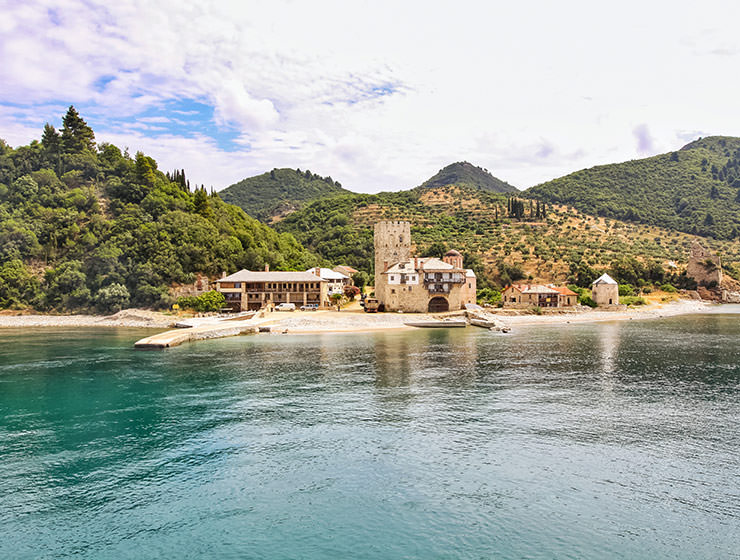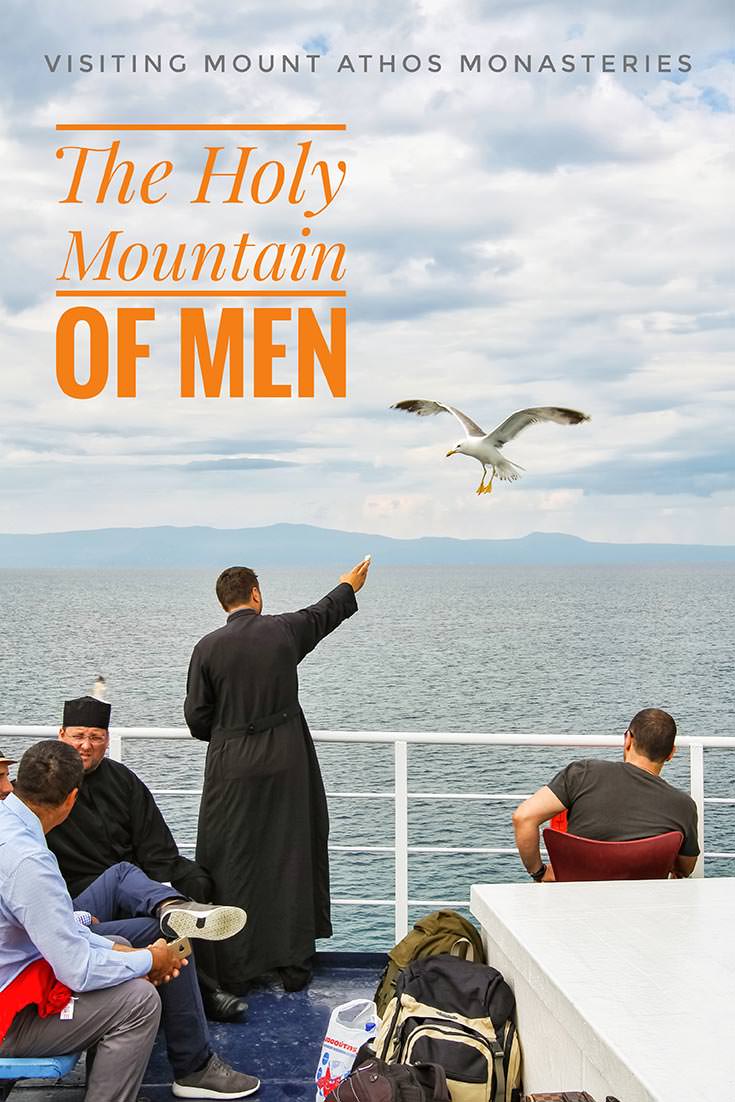Mt Athos, or Agion Oros, as they locally call this corner of Greece, is a radically strange part of the European Union. Here, EU laws on the free movement of people are restricted. By gender. Only men can visit Mount Athos monasteries! And even that is not a given.
One of these privileged beings is sitting on the pier, staring into the distance. The sea on this side of Mount Athos is not rough today. Sometimes, the waves on the easternmost leg of the Halkidiki peninsula get so wild that they cut Athos’ connections with the world.
On one of such days, Virgin Mary found refuge from the storm on these shores. Two millennia later, behind the meditating man, lies the land where women are – not welcome.
The Holy Mountain dressed in clouds, and castle-resembling Mount Athos monasteries frozen in time, mark a state within a state.
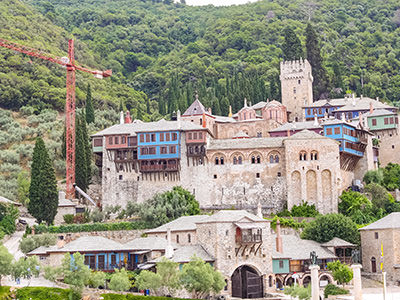
Pipeaway penetrated the fortress of Mount Athos! Take an exclusive peek into the world of Orthodox mysticism, never-ending prayer, and life at its simplest!
Mount Athos history
In northeastern Greece, some 336 square kilometers in size, the Mount Athos peninsula is an area of dense forests and pristine beaches that see no tourism.
This isolated place with no adverts and chain stores is blooming with sacral life. Here you can find 20 Orthodox monasteries, 12 sketes (cloisters), and hundreds of kellions (cells) and hermitages or caves in desolate cliffs.
The oldest surviving monastic community in the world is home to about 2000 men, priests and workers. Zero women.
Under the direct jurisdiction of the Ecumenical Patriarch of Constantinople, the Holy Mountain (Agion Oros / Ayio Oros) is often referred to as the spiritual capital of the Orthodox Christian world. In 1988, UNESCO listed Mt Athos as a World Heritage site.
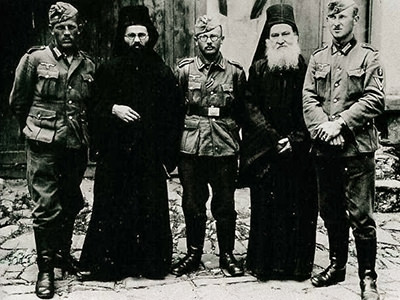
The first monks started arriving here in the fourth century. It was an uninhabited, secluded place where they believed they would be closer to God.
Throughout the centuries, the population of monks grew, supposedly reaching 20.000 in its heyday!
Different world powers had their timeshare in ‘claiming’ Mount Athos: Byzantium, Serbia, Ottoman Empire, Russia, even Nazi Germany, with Adolf Hitler proclaimed as the “High Protector of the Holy Mountain”.
Mount Athos – controversial agreement with the Führer In the Second World War, the Nazis occupied Greece. Mount Athos formally asked Adolf Hitler to place their monastic state under his personal protection, which he accepted. Swastika flags fluttered on Mount Athos, and Hitler’s portraits adorned monasteries’ walls. The monks believed that Hitler was a fulfillment of a spurious Prophecy of 1053 - a German king that will slay the Bolsheviks and the Jews, after which Germany will become an Orthodox country.
Byzantine Empire doesn’t exist since 1453, but monks are still invoking emperors’ names in their prayers. Empire’s flag is still adorning the ports of Mt Athos. The golden bull of Emperor Basil I, dated 885, which gives the monks eternal sovereignty over this controversial piece of land, is still as sacred as Bible.
Today, Mount Athos is an autonomous polity within Greece, whose Constitution protects it as the “Monastic State of Agion Oros”.
It is governed by the Holy Community, the body of representatives of the 20 monasteries, headed by Protos, the First Monk.
The capital town Karyes is also a seat of representative of the Greek state. This Civil Governor is appointed by the Greek Ministry of Foreign Affairs (!).
Ferry to Mt Athos peninsula – the seagulls’ buffet
Agion Oros could technically be an island. As one of its ancient laws forbids a “road upon which a wheel can run” to connect it to the rest of the world, visiting Mount Athos is possible only over the sea.
The access points, the towns of Ouranoupoli on the western coast of the peninsula, and Ierissos on the eastern one, are the places where female voices start to die out. As soon as one embarks on the ferry to Mount Athos, the world of men becomes omnipresent.
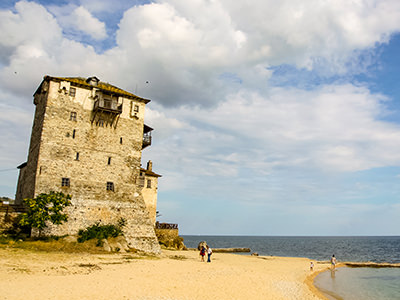
The Byzantine Tower of Prosphorio, built in the 14th century by Vatopedi monks, is the last landmark of the secular world in Ouranoupoli, the “City of Heaven”.
Black-robed priests, men with their sons, and general groups of male pilgrims armed with diamonitirion (special Mount Athos visa) and backpacks filled with only basic supplies, leave for a journey of seeking inner peace and God. Can they find Him on the Holy Mountain?
White birds descend from the skies and glide on the air streams, just next to the ferry. Unlike Biblical doves, the interest of these seagulls is quite mundane. As soon as the first priest raises his hand with a piece of bread, the feeding frenzy ritual begins.
All those potato chips, cookies and sandwiches women carefully packed for their men, in case they get hungry on their ascetic Mt Athos pilgrimage, become a snack for the birds.
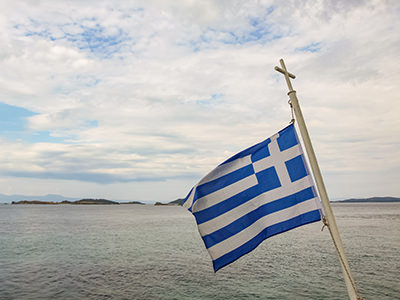
Mount Athos visa – permit as a golden ticket
Entry to Mount Athos is not as easy as buying a ferry ticket. But it is also not as complicated as online resources suggest.
For sure, without obtaining the Mount Athos visa, the aforementioned diamonitirion, there is no reason for even trying to go anywhere closer than Mount Athos cruise would allow.
Women, who are banned from approaching the peninsula closer than 500 meters, often use this cruise option as an alternative way of experiencing the Holy Mountain’s hardly accessible territory – from a safe distance.
On a daily basis, only 100 Orthodox and ten non-Orthodox men may obtain a permit for visiting Mount Athos monasteries. Each diamonitirion entitles you to a stay of 4 days (3 nights) in the Orthodox Mecca.
With online information saying that one should request it up to six months in advance, especially if he intends to visit Mount Athos during the peak summer months, I started to brainstorm on how to win this lottery. It was already June when I began considering the idea!
When I called Pilgrim’s Bureau in Thessaloniki by phone, I presented myself as non-Orthodox. The voice on the other side was not too optimistic about the potential dates for visiting Mount Athos monasteries.
How to visit Mount Athos monasteries?
The procedure for obtaining diamonitirion explained online sounded a bit complex. The Friends of Mount Athos, a UK-registered charity that aims to educate the public about the getting-to-monasteries technicalities, mentioned that, after I reserve the dates, I should send the photocopy of my passport by post, and wait for further instructions.
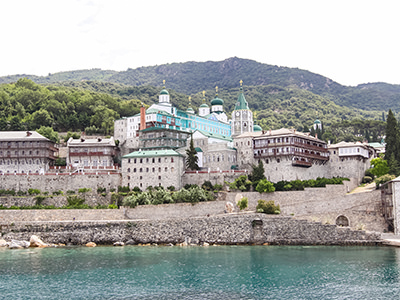
I’ve decided to skip this lengthy procedure and try my luck directly at the pilgrims’ office, once I arrive in Thessaloniki.
Then I reflected on what would be the best strategy. Should I say I was Orthodox, and raise the chance of visiting Mount Athos monasteries, at least statistically? But I didn’t know any Orthodox rituals. They would’ve figured out very quickly that I faked it. If I did admit that I was non-Orthodox, would it be better to say I was Catholic or atheist?
In the end, I arrive in Thessaloniki, enter the building at Egnatia Street 109, and with my best puppy face try to get approved by the Mount Athos office for pilgrims.
When they ask me about my religion, I answer that I’m still searching for God. I hope this could be an incentive for approval. Will they let me look for God on Mt Athos?
Only ten (10!) days later, I, seagulls, and a hundred other men will be heading to this seemingly impenetrable fortress of a land! The coast is clear!
Choosing the right Mount Athos monastery
Before jumping on a ferry, I need to select my port of departure. Ouranoupoli and Ierissos are the places where diamonitirion can wait for me.
Not knowing which monasteries I will visit at that moment, I pick the first port, on the western coast of the peninsula. It was not the best choice; I ended up planning the visit to the monasteries on the eastern seaboard! Double-check Mount Athos map of monasteries if you don’t make the same mistake.
Armed with the list of phone numbers I got at the Pilgrim’s Bureau in Thessaloniki, I start dialing the selected ones. Staying in monasteries is free, but one needs to reserve his place in advance.
View this post on Instagram
A woman answers one of the calls. Erm, obviously wrong number on this Mount Athos monasteries list!
Some of them, such as Simonos Petra, welcome me with an answering machine, for days.
On the phone of Megisti Lavra (Great Lavra), the oldest Mount Athos monastery, an impatient monk answers “Yes, you can come!”. And then hangs up. No additional questions allowed.
In the end, I decide to spend one night in Iviron, and two nights in Vatopedi, the second oldest monastery on the peninsula.
Officially, one can stay only one night in each Mount Athos monastery. But Vatopedi monk is polite enough to offer that, if I can’t find an available place in other monasteries, I can stay more than one day with them.
So instead of booking one night in Megisti Lavra which is welcoming me with apparent nervousness, I end up reserving two nights in Vatopedi which is providing a welcome with a smile.
If you are impressed with sacral architecture at Mt Athos, check out this incredible private building project in Indonesia - the Chicken Church!
Thessaloniki to Mt Athos
After a local bus ride from Thessaloniki city center to KTEL Halkidikis station (0,50 Euros), I take the direct bus to Ouranoupoli (13,70 Euros).
Next to me sits a homeless-looking man. His hair is greasy, his beard messy. Dressed in a winter coat at the very beginning of the proverbially hot Greek summer, he engages in the repetitive gesture of making a sign of the cross over his forehead, chest, and shoulders. After five minutes, he leaves the seat.
Another passenger appears asking for a pencil. Then he continues talking to invisible people.
Am I on the right bus? Is this the typical profile of pilgrims who visit Mount Athos?
We arrive in Ouranoupoli, the last settlement before the monastic state of Mount Athos, and I spend my night there.
As I said, it is a mistake, as it would’ve been much more practical if I would’ve ordered my visa to arrive in Ierissos (the port for the eastern monasteries).
I even have a small but pleasant place to recommend there – GKEEA Boutique Hotel! But more on this later, as I do find it to be a useful stopover even after finishing Mount Athos monasteries visit!
In the morning, I arrive at the window of the pilgrim’s office among the first visitors and collect my diamonitirion.
They ask again if I’m Catholic. I start to stutter that they raised me like one, but that I’m still looking… The official writes katholikos on my precious piece of paper. There is no room for nuances.
Nevertheless, I pay 25 Euros, which I thought is a price for Orthodox visitors. Everyone else should pay 10 Euros more. Well, the lower price never made me sad. And finally, I have the paper!
Mount Athos travel – ferry, bus, van
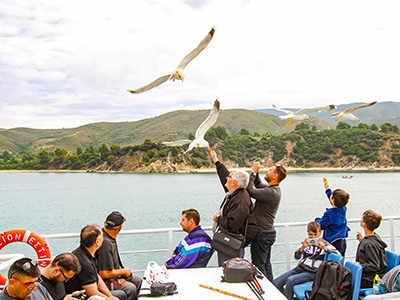
From Ouranoupoli, the Mount Athos ferry takes us to Dafni (6,89 Euros).
Before docking at the main western-side port, the ship passes the coastline sprinkled with old ruins, skete settlements, but also several monasteries still encircled by the construction cranes.
Docheiariou, Xenophontos, and then, the largest on the peninsula, Saint Panteleimon Monastery (the Russian monastery on Mount Athos) impress with their size, fortified walls, towers, and domes.
A bus takes us from Dafni to Karyes (3,50 Euros). In the middle of the peninsula, this is the administrative center of the Holy Mountain. It’s a typical transfer place when traveling from one Mount Athos monastery to the other.
They do not display the transfers’ schedule, so good luck with asking around! However, as long as you have reserved the accommodation in your next monastery, there should be space for you in the van going there! While you wait for the van’s departure, you can get some supplies in the local shops or eat in a couple of restaurants.
One of the monks is pressing a bottle of cooled spirit against his jaw. It makes it easier to remember the name of this picturesque little town – Karyes!
Even if monks rarely get sick, as they generally live healthy and stressless lives, and follow the Mount Athos diet, there is a clinic in Karyes. I notice one of the monks pressing a bottle of cooled spirit against his jaw. I don’t know if this is an old Mount Athos recipe in treating a cavity. The memorable image definitely helps me not to forget the name of this picturesque little town.
The Holy Mountain as the Garden of Virgin Mary
Another van ride later (2 Euros), and there it is! In the middle of the eastern coast of Mt Athos, with two towers that defended it against the raids of the pirates and other intruders, stands the famous Monastery of Iviron (or Iveron).
It looks as if someone melted white, blue and red houses of various sizes together into a gigantic, very monumental fortress. Georgian monks built it in 976, on the foundations of the Clement’s Monastery from the 8th century.
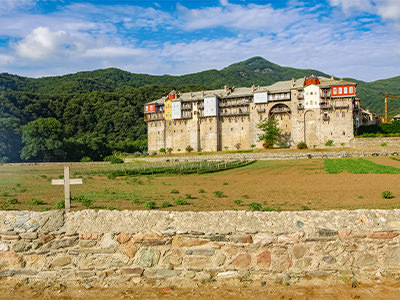
This imposing monastery is dedicated to the Assumption. According to the local legend, Virgin Mary stepped on Athos land exactly here.
It happened in her old age when she and St John the Evangelist sailed from Jaffa to Cyprus to visit Lazarus. The storm blew the ship off course, and they ended up at Athos, close to the site of today’s Iviron. If you know anything about geography, you understand that this had to be a hell of a storm!
The Virgin stepped ashore and, struck by the natural beauty of the place, she prayed to her Son to give her the mountain as her garden. A voice approved her request. From that moment on, the mountain was consecrated as the Garden of the Mother of God.
Virgin Mary paid a visit to Mount Athos even later, in 1004, in the form of an icon known as Panagia Portaitissa. Firstly, a column of fire connected the sky and the sea in front of Iviron Monastery. Then the painting made by the apostle Luke miraculously appeared in the sea, floating upright. Anchorite monk Gabriel walked on water, took the icon, and brought it to the shore. At the place where he put the icon off, holy water spurted, the legend says, and it streamed until today.
In different parts of the world, God is celebrated through a variety of mysteries. For instance, Christians in the Philippines go through an actual crucifixion at Maleldo Festival.
No females allowed in Mount Athos monasteries, animals included!
It is not just the monks of Mount Athos who call their peninsula the Garden of the Virgin Mary. The state of Greece accepts that the land belongs to only one woman and, for all other female visitors, visiting Mount Athos is forbidden.
Monks believe that the presence of women would alter their community, lead them to sin, and slow down their path to spiritual enlightenment.
The ban on Mount Athos entry for women, called Avaton, has been officially proclaimed by several emperors, including the chrysobull of Constantine Monomachos in 1046.
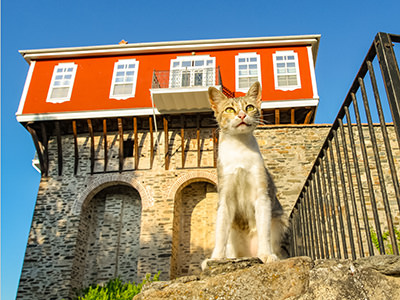
Believe it or not, the ban still includes female animals! It is not entirely clear why, but monks believe that it is a short path from allowing cows, ewes and mares on Mt Athos farm to allowing women to enter their land. So they keep the ban wide.
This means Easter on Mount Athos includes importing chicken eggs so they can paint them!
Mount Athos diet throughout the year is mainly vegetarian as in that case there is no reason for having female animals for enabling reproduction.
The only domestic animal that is allowed to be female is a cat, as they find it useful in controlling the population of rodents. So dear women, until you start killing rats with bare hands and teeth, it seems there is no room for you on the Holy Mountain!
Once in Indonesia, I shared accommodation with rats. And that's just one of my bizarre Couchsurfing stories!
Sacral Mykonos – Mount Athos homosexuality under cover of celibacy?
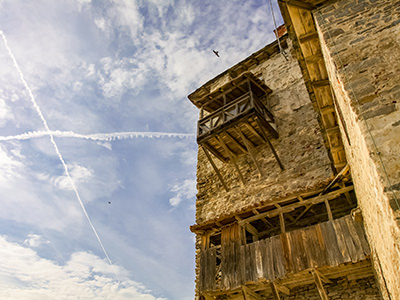
The story of women and Mount Athos is constantly raising controversy.
Some female prime ministers in the European Union, as well as the European Parliament itself (in 2003), requested to lift the ban, as Avaton is violating the UN’s core principle of gender equality.
They did not succeed. Mt Athos managed to remain probably the largest area on the planet where women are forbidden.
The first women who breached the Avaton had a lot of money.
In the 14th century, Serbian empress Jelena, the wife of the emperor Dusan, was fleeing the plague epidemics in the Balkans. Monks, however, didn’t allow Jelena’s feet to touch the ground, so she was constantly carried around by her servants.
A century later, another Serbian woman was visiting Mount Athos. Princess Mara Brankovic was granted the entrance permit because of her influence in the Ottoman Empire.
In ancient Greece, a woman was not persona non grata in sacred places. Actually, a Greek woman named Pythia became the priestess and one of the most powerful figures of her time. Read more about Delphi, the famous Greek oracle!

Then, some women literally broke in. In 1929, French writer Maryse Choisy claimed she underwent a mastectomy and disguised herself as a sailor, only to check what all the fuss about Mt Athos was.
She ended up writing a book about her supposedly month-long undercover Mount Athos visit, “Un Mois Chez Les Hommes” (“A Month with Men”). She described how the “kinky monk” continually spoke to her (him) of his desire for making love. Maryse’s Mount Athos experience was debunked as fake.
In 1932, one woman disguised as a sailor managed to sneak in! It was Aliki Diplarakou, the first Greek winner of the Miss Europe title.
Not knowing that she was a woman, one of the young monks at Vatopedi Monastery (today unofficially considered to be the monastery with the largest concentration of Mount Athos gay priests) flirted with her. This story ended up with an anathema: Patriarch Photios II publicly cursed the miss for her act!
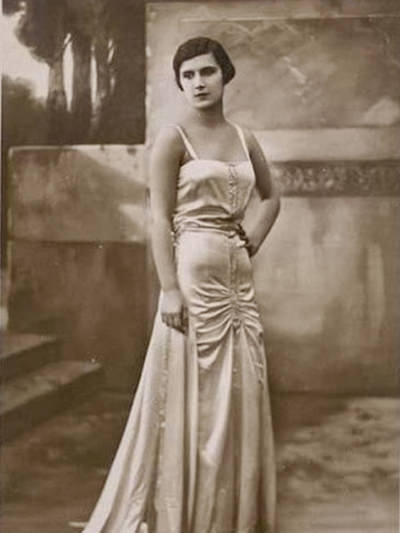
Maria Poimenidou, a woman from Thessaloniki, successfully disguised as a man and infiltrated among the monks of Mount Athos in 1953.
Monks had enough, and Greece passed the law that penalizes such offenses with 12 months in jail! So you’ve been warned!
As for Mount Athos homosexuality behind the walls of the monasteries, the public debated about it more than several times.
Greek press went so far that it reported about motorboats serving Athos harbors with male prostitutes, and published that young boys were even being kidnapped for the monks’ needs.
Father Michael Haztiantoniou, who lived there for 15 years, publically spoke about the cover-ups both for “gay incidents” in Mount Athos brotherhoods, as well as the use of psychotropic drugs in controlling the monks.
Mount Athos mythology In Greek mythology, Athos was a Thracian giant who fought Poseidon, the Greek god of the sea. One story says that Athos threw a massive rock at the god, it fell into the sea and became what we know today as Mount Athos. The others say that it was Poseidon who threw the rock at the giant and buried him underneath.
Iviron Monastery and Van Gogh
My arrival in Iviron, the first fence of the Virgin Mary’s garden, is followed by confusion. I exit the van with other pilgrims. After climbing to the main gates of the fortress, I try to look for anything that would resemble a reception. I find none.
At the monastery’s souvenir shop, I approach some monk to ask what to do. He directs me to go directly to Archontariki (where?) or, if it is too early to check-in, to go and eat something (where?).
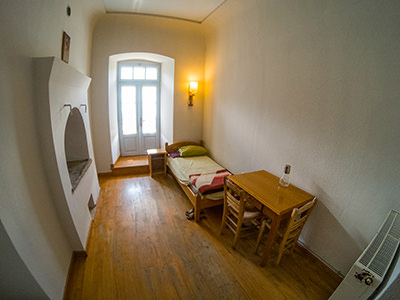
After wandering a bit around the vast complex, I find the entrance to the guesthouse (Archontariki, it is!). Other pilgrims are already waiting to get checked in.
In the adjoined little kitchenette, dry bread and jam. One pilgrim is greedily swallowing olives and looking around what else could he eat in this self-service place.
Everyone else is sitting in the waiting room, doing everything like others: nothing.
One hour later, a younger monk appears, opens the big book, and leaves again. It is a game of patience.
Finally, after some time, they assign our rooms. Modest as Van Gogh’s “Bedroom”, mine is equipped with a simple bed, table with two chairs, a portrait of Jesus under the lamp, and cozy balcony looking at the monastery’s salad field.
Welcome with a stick
I jump from my three-quarter pants to the full-length trousers to adhere to the monasteries’ dress code. Then I descend to the courtyard just before the Vespers, the evening prayer service.
In front of the katholikon, the main church of the monastery, an old monk is sitting on the bench. Waving with his walking stick, he makes a gesture that invites me to join him.
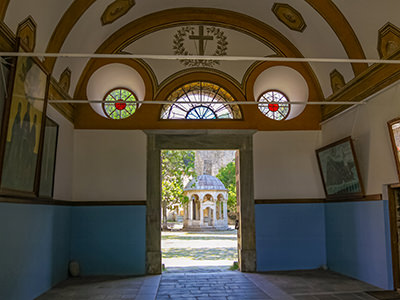
“Where are you from?”, he asks.
“Croatia”, I answer.
“Russia?”
“No, Croatia.”
“Serbia?”
“No, Cro-a-ti-a!”
“Kroatia?”, he pronounces now with a heavy accent and then catches me off guard.
He swirls his walking stick through the air and hits my legs with it! What did just happen?
I’m definitely surprised by his special physical welcome. But I assume this is some fun initiation game for him, in the absence of television and other entertainment services available in the secular world. From further amusement with a stick, I’m saved by the bell.
I know a place in Europe where a greeting by an authority with a stick would be considered super welcome. It's called Folsom Berlin, the largest European gay fetish event!
Sacred service at Mount Athos monasteries
Well, instead of church bells announcing the mass service, here one of the monks is walking around the church while banging with a mallet on a semantron, a long wooden plank, in the specific rhythm recognized as the call for worship. In the following days, this repetitive music will engrave in my hearing memory.
The old monk addresses the other pilgrims he didn’t have the time to whack with his stick and just firmly brandishes towards the church door. He exclaims: “Messa!”
Then he slowly limps away. He might not have power in his legs, but those arms can strike!
Other monks start flocking through the church doors. They kiss icons when passing, in a speedy ritual, as if they are late. Their swaying robes while they fly through the church, from one painting to another, add to the atmosphere of the rush.
I’m not an expert on Orthodox rituals, but the layman would see Mount Athos monks chanting, murmuring prayers, opening and closing the curtains, lighting and putting out the candles, and walking through the exquisitely ornate church while osculating the holy icons.
Liturgical services are the center of the monastery’s life, and while some monasteries expressly require participation, Iviron – suggests it.
Kissing, touching, and interacting with a variety of meaningful artworks is not just a religious specialty. Learn more about the bizarre phenomenon of statue rubbing!
Male pigs are allowed on Agion Oros
Dinner at the Mount Athos monastery starts just after the sacred service. When church doors close, the refectory ones open.
Long tables with served plates await. Monks sit at one part of the dining hall, the pilgrims at the other.
Even if Mount Athos recipes are typically vegetarian, delicious fish is served tonight, with zucchini and garlic in the sauce, raw vegetables, and olives for make-your-own salad.
Famous Mount Athos wine for drinks, and some cherries for dessert.
After licking their plates clean, pilgrims are stealing slices of bread and stuffing their pockets with cherries. Some of them are bragging how they furtively took two tomatoes “for later”
During the meal, one of the monks (Anagnostis) is serving food for thought. He is reading from the holy books. When he finishes, dinner ends as well.
This limited and never exact time for dining pushes some pilgrims over the edge of basic courtesy. Every day, when Mount Athos gourmet food magically appears, I see these pious palmers transforming into insatiable pigs! I’m sorry if my words sound harsh, but I’m utterly shocked and almost ashamed seeing them devouring this free supper in the wildest manner, which undoubtedly no Holy Script prescribes.
After licking their plates clean, they’re stealing slices of bread and stuffing their pockets with cherries. In front of the refectory, I hear several Serbs bragging how they furtively took two tomatoes “for later”.
My incognito solo appearance (helped by the fact that I speak English to everyone), makes other Slavic people talk more freely in my proximity, believing that nobody can understand them.
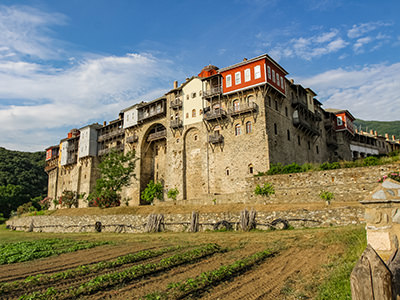
New day, a new monastery. Or not?
The next morning, at 03:30, the rhythmical knocking on semantron again. As the busy receptionist monk didn’t explain the services schedule, I sleep over this call for Orthros, the morning service, followed by the Divine Liturgy.
At 07:45, young civil men kick us out of our rooms, as they need to change the sheets for the new guests.
I hear the same group of Serbs, apparently very satisfied with Iviron service and Mount Athos menu choices, plotting the plan on how to bypass the proclaimed limit of one-day stay per monastery.
“We will stay here for 4-5 days more, eight of us!”, the first one says, boosting with confidence that rules can be bent.
“Yesterday you talked to this one at the reception”, comments the second one. “You got a captain, and he didn’t know to open his mouth!”
“The only question is how to turn him around”, the first one looks concerned.
“Well, we will call him by phone!”
Checkpoints to Vatopedi
I didn’t have time to find out about the end of the Serbian sacral holidays’ adventure. The bus was leaving for Karyes (2 Euros), and then another van to Vatopedi (4 Euros).
On the way, we see some pilgrims hiking; this is another way of traveling between the monasteries. As long as you are ready to walk in the dress code of Mount Athos, which typically means not much skin exposure, trekking between monasteries is a great way to see nature untouched for centuries.
For the rest of us, the air-conditioned bus sounds like a much more comfortable option.
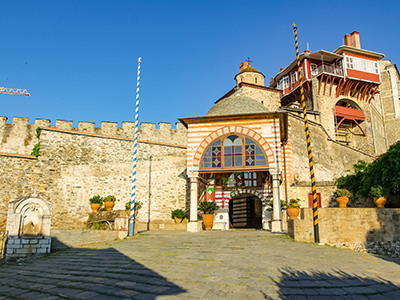
At half of the way, the control point. An officer is checking who is going where and whether our names are on his Mount Athos monasteries list.
After arrival in Vatopedi Monastery, the gatekeeper registers me in his list too. He asks what my profession is.
“Journalist”, I answer.
“You have chosen the worst job in the world!”, he comments.
Sure, I could have asked back if there were no other jobs left for him except the doorman. But I didn’t want to offend his ‘sacred’ dress, primarily because I would never call the doorman’s job the worst job in the world anyway.
The hospitality of Greek Orthodox monasteries
His colleague monk at the reception hall, archontaris (the guest master), provides a much more warmhearted welcome. After offering us some ouzo, water, and lokum, he gives us an introduction speech. In Russian for the Russian pilgrims, in Greek for the Greek ones, and in English for me.
He asks if I need any assistance with my departure and, unlike in Iviron, informs me about the precise schedule of the church services. The afternoon one is at 5 pm, followed by dinner, and then introducing the relics kept in the monastery. The prayer in the morning starts at 4 am and is followed by mass and breakfast.
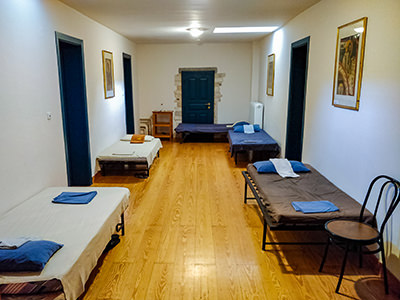
Even if Vatopedi is supposedly one of the more luxurious monasteries on Agion Oros, unlike older pilgrims who got their private rooms, they send me to a dormitory-style room in the attic, to share it with young seminarians, future monks.
There is only one shower on the entire floor (a clogged one, though), but even that is progress! Most of the monasteries on the Holy Mountain do not have bathing facilities. Iviron has only essential sinks! So who can complain about the clogged shower?
What do we need for happiness?
Dinner at Vatopedi seems to be a bit less authentic than the one in Iviron. Industrial-made bread, tetrapak compote, and some lentils. Still, one pilgrim takes the mobile phone and, against the rules, snaps a photo of the food. Some Instagram feeds do not need to impress.
It also seems that they impose the hierarchy much more in Vatopedi. Unlike in Iviron, where monks and pilgrims were entering the trapeza (refectory) together, here dozens of priests have the exclusive priority. Nobody is let into the dining room before the last monk passes through the doors.
I meet Aleksandar, a polite 15-year old student of the first grade in Niš seminary, Serbia.
Historically, underage boys were not allowed to enter the Holy Mountain. Now, if their father or responsible elders accompany them, they can discover this peninsula as well.
Aleksandar seems happy about their Mount Athos excursion, especially because they go to Ierissos after they visit Mount Athos monasteries.
“What’s so exciting about Ierissos?”, I ask.
“Well, swimming!”, Aleksandar answers, with a spark of happiness in his eyes.
Boys are boys. Summer is summer.
While swimming or even public undressing in shorts is not allowed during your Mount Athos visit, there are parts of the country where you can behave completely freely. Check at least some of the best nude beaches in Greece!
The wonders of the holy relics
After dinner, we get a tour of the monastery’s relics, a source of many Mount Athos miracles. A red-faced priest takes off his cap, revealing the clear suntan line across his forehead. On the table in front of him, portions of the True Cross, various bones, skulls, dried-up parts of saints’ bodies. Relics invite the participants of Mount Athos pilgrimage to kneel in front of them and kiss them.
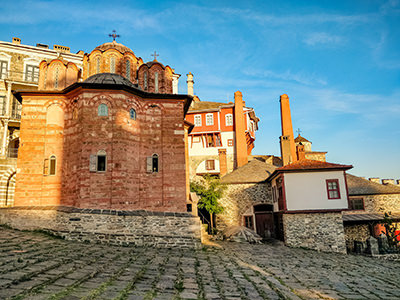
Supposedly, Virgin Mary’s belt has unique miraculous characteristics. One of the priests explains that it proved very successful with female infertility; it heals women who have problems with getting pregnant.
My curious mind cannot help but wonder why they keep this miraculous belt that cures infertile women on Mount Athos – that no woman can approach closer than 500 meters from the shore. But I keep it for myself.
While they are telling us the story of the miraculous icon on which the portrayed baby Jesus supposedly came to life and tried to cover the mouth of the Virgin Mary who warned Mount Athos monks about the invading pirates, the young seminarians listen with awe.
Well, one looks rather bored. His priest teacher sends him away “as he is obviously not interested”. On the other hand, he instructs Aleksandar to bring “two books and three bottles of wine” from the room, so they can thank their hosts for giving us the tour of the Mount Athos treasures, which is only a small part of the largest collection of Christian art in the world.
How to become a monk on Mount Athos? If you’ve considered joining Mount Athos monasteries, here is how to become a monk on the Holy Mountain! First of all, you need to be an adult Orthodox Christian. You choose a monastery and present your application to the Committee. If they accept you, they will approve the initiation period which usually lasts three years. This will be the time when they will test your capacities for becoming a monk, while you’ll work as a helping hand in the monastery. The abbot, the head of the monastery, will approve when you are ready to take your vows. If ordained, you will fully immerse yourself into the Mount Athos monks lifestyle, the life of continuous prayer and communication with God.
Visiting Mount Athos – a place without a sunset
I walk over the coastline of Mt Athos, clearly overdressed for summer. I reflect on this isolated world, full of rules that should not be questioned.
Behind the beach that nobody swam for a thousand years, there is a small chapel and a sizeable rusted metal cross. It seems like a beautiful place to watch the sunset, but there’s no time. The monastery’s doors will close at 8:30 sharp, and the gatekeeper will not let anyone into the fortress after that.
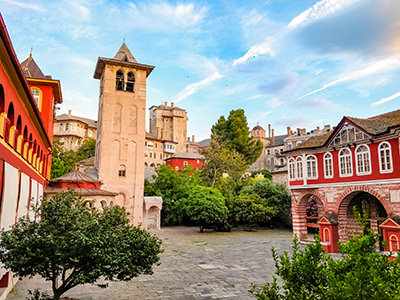
The center of Vatopedi resembles a small Mediterranean village, with the exception that it is hidden behind the walls. Pilgrims stand around the vast paved piazza, checking their mobile phones, some talking to each other. Monks are finishing their daily chores.
The time for the night prayer arrives soon. Semantron will wake them for the morning prayer at 4 am.
They will all gather in the dark ambient of the church, with the trembling light of the candles and oil lamps, until the blue morning light spills in through the windows together with the twitter of just awoken birds. Some monks will be dozing off through the prayers; some will never stop praying.
The cycle of life turns daily here. And nothing really changes! Besides the Mount Athos visitors.
Invisible monks and invisible pilgrims
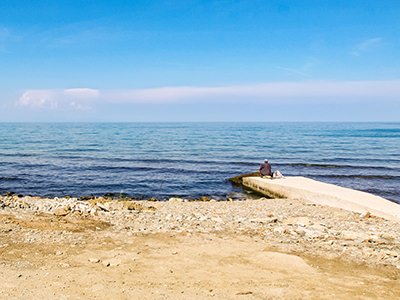
During my 4-day visit to Mount Athos monasteries, no monk approached me (besides the one who welcomed me with a stick). Out of dozens and dozens of monks in both monasteries, none of them showed any curiosity towards the only visitor who didn’t pray and didn’t kiss the icons.
I felt alone. Maybe that is the whole idea? Perhaps Mt Athos is the place to get together in order to experience the solitude? With everyone else, equally alone?
A dozen monks left the monasteries and, while wandering around the Holy Mountain, received the gift of becoming invisible. These naked hermits will perform the last Liturgy before the second arrival of Christ
Some monks have chosen such a degree of solitude that they even left monasteries, sketes, and cells. Not many people have seen these naked hermits who live in the Garden of the Virgin Mary without any shelter, even when it snows.
The story says that these ascetics reached such a level of enlightenment that they’ve received the gift of becoming invisible! Bathed in Uncreated Light, these special anchorites appear when they want, usually in the presence of monks with purified hearts and some blessed pilgrims.
They estimate that between 7 and 12 of these strict ascetics ramble in the most isolated areas of the Holy Mountain.
Supposedly, when the end days come, just before Christ’s second arrival, the invisible elders would be the ones who would perform the last Liturgy in the world, on the peak of Athos.
Sacral time machine
Before embarking on the boat to Ierissos (10,40 Euros), a policeman asks me: “Icons?”
Besides stealing objects, it is also forbidden to steal videos from the Holy Mountain. But nobody checks for that. “No filming” stays just the warning from the times when one had to have a video camera to do it.
The times change. New monks know about mobile phones, about the internet.
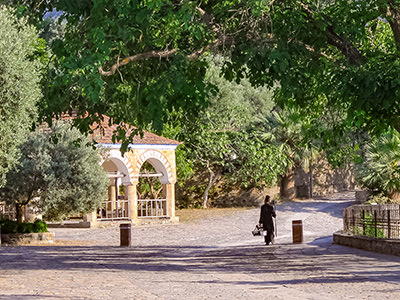
Some monasteries on Mount Athos still survive without even having electricity. Vehicles are quite a recent add-on to Athos’ life too; just 25 years ago, almost everyone was traveling on foot.
While it is true that Athos lives by the Julian calendar, some would argue that they are not just 13 days behind the rest of Europe!
In Ierissos port, as soon as the boat docks, young seminarians undress quickly and run into the sea. Waiving the summer pleasures for four days is a little sacrifice. Waiving them for a lifetime is a whole other story!
Where to stay in Ierissos
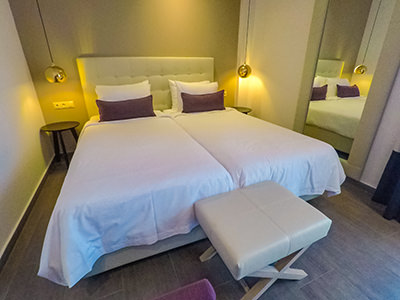
GKEEA Boutique Hotel
After four days of being away from civilization, while living on a hygienic minimum and with time-restricted meals, one needs a bit of recovery.
In Ierissos, I found GKEEA Boutique Hotel; the owners renovated this stylish property in 2015.
Welcome with an open bar with local liqueurs, a comfortable air-conditioned room, and a bathroom with all essential amenities, felt like a true luxury one craves after the ascetic journey to the Holy Mountain.
Finally enjoying the hot shower makes you less guilty when you know the solar energy heated it, technically God himself, so the monks of Mount Athos should approve this tiny bit of luxury at GKEEA Boutique Hotel too.

Probably my favorite part of the stay in GKEEA was its wonderful buffet breakfast. I know this is one of the best boutique hotels in the vicinity of Mount Athos, but for a small and intimate hotel, I wasn’t expecting so many choices that were brightening my mornings here with healthy and organic food, with local produce freshly prepared for the guests! Amazing!
Ierissos looks like a laidback summer resort town. Its long stretch of beach, which is just 100 meters from GKEEA Boutique Hotel, is a perfect place to anchor the female part of the family, while you leave for the male-only Mount Athos retreat.
If you want to learn more about the Holy Mountain, check how the CBS documentary “60 Minutes” portrayed Mount Athos!
Mount Athos facts
- Country: Greece
- Government: Autonomous theocratic society
- Mount Athos population (2011): 1811
- Mount Athos size: 335,63 km2
- The height of Mount Athos peak: 2033 m
- The capital of the polity: Karyes
- The closest airport to Mount Athos: Makedonia Airport – Thessaloniki
- Mount Athos contact information: +30 2310 252578, athosreservation@gmail.com
- Mount Athos official website: www.agioritikiestia.gr
Did you like this article about visiting Mount Athos monasteries?
Pin it for later!
Disclosure: My stay at GKEEA Boutique Hotel was complimentary, but all opinions are my own. Also, this post contains affiliate links, which means if you click on them and make a purchase, Pipeaway might make a small commission, at no additional cost to you. Thank you for supporting our work!

